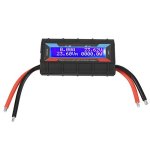For a wattmeter to be useful as anything other than a voltmeter (which you can just use a cheap multimeter for), you'd need to leave the wattmeter wired in series between the battery and the controller all the time, so it can count up the ah / wh used, and then if you know the actual ah / wh capacity of the battery, and start out with it fully charged, then you can subtract the ah / wh used from the known capacity, and know how much you have left.
You don't want to leave the wattmeter connected to the battery unless you're using the system since it can drain a typical ebike battery in a few days or so, especially if it's closer to empty than full. However, most of those wattmeters don't retain info when not powered by the battery, so then you can't keep track of the ah / wh used unless you write everything down and add it all up manually. Some have a place for a secondary battery to connect to to keep this data there, and then you can just reset it when you charge back to full. Some, like the Cycle Analyst, do remember the data when powered off, but since the CA is not just a battery meter, but rather a whole ebike computer, it's a lot more expensive than the cheap RC wattmeters--and as a wattmeter, it *also* measures current both directions, so it can measure recharging too if that is done thru the same port you discahrge with (some batteries have a separate port, some don't).
If you just want to know the voltage, you can use any cheap voltmeter or multimeter, and connect the probes to your battery output when you want to check it. Or permanently wire it in, since the multimeter has it's own battery and won't drain your ebike battery just sitting there connected as a voltmeter. (though it only tells you voltage, not actual used capacity).
There are also simple "bargraph" voltmeters for specific battery types / voltages, which you could wire to a pushbutton on the battery wiring (or install in the case), to just "push to test" whenever you wanted to know approximately how charged it is (like the LED meter that isn't working in your battery right now). This image search shows a number of types; I don't have any specific info on any particular one shown there
https://www.google.com/search?q=ebike+bargraph+battery+voltmeter&tbm=isch
Regarding your existing battery LED meter, it's probably just disconnected inside the battery (broken wire, bad solder joint, etc). Some battery cases have a place for a meter but it's not actually installed (cheap manufacturer).



